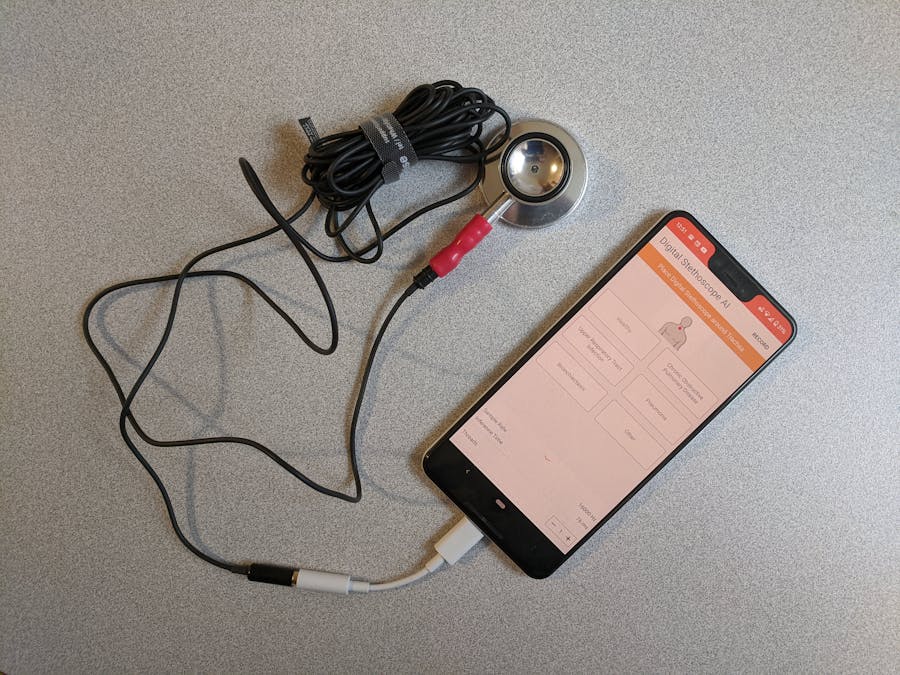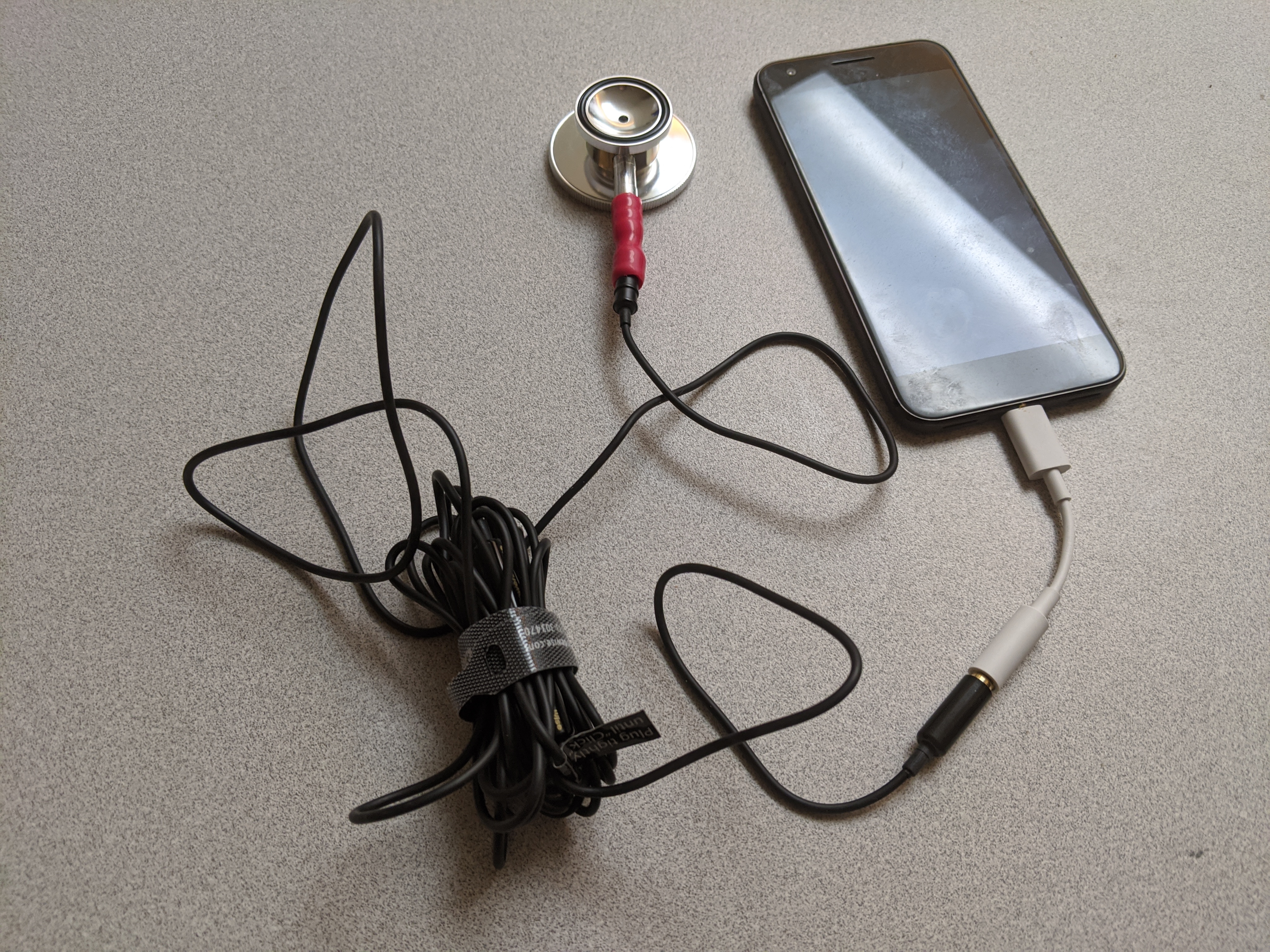We all know COVID19 is extremely contagious by now, and shortage in healthcare provider is already happening in first world, this would only further escalate in 3rd world nations who do not have much resources. By being part of UN Sustainable Development Goal 3, we want to innovate in this area and able to be able to help everyone in the world. We are team MixPose, a live streaming yoga class company, and we want to build something that can help with COVID19.
Telemedicine have been maturing for the past decade, and many have expected after COVID19, this will be pushed towards mainstream. This also allows doctors working remotely to treat people in developing nations, that's in dire need of healthcare resources right now. Every doctor wears a stethoscope, they can use that to diagnose symptoms for the patients.
The digital stethoscopes in the market is generally not affordable at individual level, especially in Developing nations and struggling communities, they are a great tool for the doctor, but in telemedicine, we need the tool to be able to diagnose patients remotely. In case of no doctors available for Developing Nations, we need AI that's affordable to do that diagnosis.
Affordable Digital Stethoscopes with AISo we want to build an open sourced digital stethoscopes that's under $1.00 and can easily be given to everyone in the world, so that we can empower doctors via telemedicine to treat more people.
In this project, we will also train an AI to use sound classification so that patients can do a self checkup anytime, and when the AI detects possible symptoms, the audio data is recorded for the patients to send it to a doctor for a further checkup.
To make this, we only need a normal Stethoscope and a tiny microphone, the Stethoscope can be purchased $5 retail, the Microphone for another $5 retail. Although this adds up to $10 retail, we do not need most of the parts. Also, if we were to order these whole sale, we can easily cut the entire bill of material down to about $1.
Now that we have the materials, we can cut the scope itself and attach directly to the small microphone. This would allow sound goes directly through microphone itself coming from the plate. Full building instruction can be seen below.
This step is enough for those simply want to make an affordable stethoscope and record your own heart rate or breath.
Step 2: Recording from StethoscopeNow that we have built a digital stethoscope from off the shelf material, we can use that to record our heart as well as our respiratory system. The recording can be done via our computer or our phone, making it much more accessible around the world
In Developing Nations, phones are much more common for recording, the 3.5mm is universal among all phones, for those who does not have it, a usb adapter can be very easily obtained.
When all said and done, you can see it like below.
Step 3: Training Tensorflow Sound Classification AIUsers now can record their own internal sound from Stethoscope, we will tensorflow sound classification to determine whether it's COVID related such as Pneumonia, or other disease which you can wait for.
We can train this part on the cloud, for this article we can easily spin up a GPU server server using Tensorflow 2.2 on Google Cloud Platform
This would have most of the prerequisite installed, and we can go straight into modification in the ubuntu system itself. We will be working with modified version of speech command example.
$ mkdir workspace
$ cd workspace
$ mkdir tmp
$ cd tmp
$ git clone https://github.com/tensorflow/tensorflow.git
$ cd ~/workspace/tmp/tensorflow/tensorflow/examples/speech_commandsTo check Tensorflow is properly installed
import tensorflow as tf
print(tf.version.VERSION)As for data, we can retrieve data from different sources. For this project we will be able to classify 5 different types of sound. To make the project simple, we will focus on Trachea, except for heart rate, which we will be using stethoscope on the heart.
- Healthy
- Chronic Obstructive Pulmonary Disease
- Pneumonia (often associated symtom with COVID19)
- Upper Respiratory Tract Infection
We have to change train.py to following format
# Copyright 2017 The TensorFlow Authors. All Rights Reserved.
#
# Licensed under the Apache License, Version 2.0 (the "License");
# you may not use this file except in compliance with the License.
# You may obtain a copy of the License at
#
# http://www.apache.org/licenses/LICENSE-2.0
#
# Unless required by applicable law or agreed to in writing, software
# distributed under the License is distributed on an "AS IS" BASIS,
# WITHOUT WARRANTIES OR CONDITIONS OF ANY KIND, either express or implied.
# See the License for the specific language governing permissions and
# limitations under the License.
# ==============================================================================
"""Simple speech recognition to spot a limited number of keywords.
This is a self-contained example script that will train a very basic audio
recognition model in TensorFlow. It downloads the necessary training data and
runs with reasonable defaults to train within a few hours even only using a CPU.
For more information, please see
https://www.tensorflow.org/tutorials/audio_recognition.
It is intended as an introduction to using neural networks for audio
recognition, and is not a full speech recognition system. For more advanced
speech systems, I recommend looking into Kaldi. This network uses a keyword
detection style to spot discrete words from a small vocabulary, consisting of
"yes", "no", "up", "down", "left", "right", "on", "off", "stop", and "go".
To run the training process, use:
bazel run tensorflow/examples/speech_commands:train
This will write out checkpoints to /tmp/speech_commands_train/, and will
download over 1GB of open source training data, so you'll need enough free space
and a good internet connection. The default data is a collection of thousands of
one-second .wav files, each containing one spoken word. This data set is
collected from https://aiyprojects.withgoogle.com/open_speech_recording, please
consider contributing to help improve this and other models!
As training progresses, it will print out its accuracy metrics, which should
rise above 90% by the end. Once it's complete, you can run the freeze script to
get a binary GraphDef that you can easily deploy on mobile applications.
If you want to train on your own data, you'll need to create .wavs with your
recordings, all at a consistent length, and then arrange them into subfolders
organized by label. For example, here's a possible file structure:
my_wavs >
up >
audio_0.wav
audio_1.wav
down >
audio_2.wav
audio_3.wav
other>
audio_4.wav
audio_5.wav
You'll also need to tell the script what labels to look for, using the
`--wanted_words` argument. In this case, 'up,down' might be what you want, and
the audio in the 'other' folder would be used to train an 'unknown' category.
To pull this all together, you'd run:
bazel run tensorflow/examples/speech_commands:train -- \
--data_dir=my_wavs --wanted_words=up,down
"""
from __future__ import absolute_import
from __future__ import division
from __future__ import print_function
import argparse
import os.path
import sys
import numpy as np
from six.moves import xrange # pylint: disable=redefined-builtin
import tensorflow as tf
import input_data
import models
from tensorflow.python.platform import gfile
FLAGS = None
def main(_):
# Set the verbosity based on flags (default is INFO, so we see all messages)
tf.compat.v1.logging.set_verbosity(FLAGS.verbosity)
# Start a new TensorFlow session.
sess = tf.compat.v1.InteractiveSession()
# Begin by making sure we have the training data we need. If you already have
# training data of your own, use `--data_url= ` on the command line to avoid
# downloading.
model_settings = models.prepare_model_settings(
len(input_data.prepare_words_list(FLAGS.wanted_words.split(','))),
FLAGS.sample_rate, FLAGS.clip_duration_ms, FLAGS.window_size_ms,
FLAGS.window_stride_ms, FLAGS.feature_bin_count, FLAGS.preprocess)
audio_processor = input_data.AudioProcessor(
FLAGS.data_url, FLAGS.data_dir,
FLAGS.silence_percentage, FLAGS.unknown_percentage,
FLAGS.wanted_words.split(','), FLAGS.validation_percentage,
FLAGS.testing_percentage, model_settings, FLAGS.summaries_dir)
fingerprint_size = model_settings['fingerprint_size']
label_count = model_settings['label_count']
time_shift_samples = int((FLAGS.time_shift_ms * FLAGS.sample_rate) / 1000)
# Figure out the learning rates for each training phase. Since it's often
# effective to have high learning rates at the start of training, followed by
# lower levels towards the end, the number of steps and learning rates can be
# specified as comma-separated lists to define the rate at each stage. For
# example --how_many_training_steps=10000,3000 --learning_rate=0.001,0.0001
# will run 13,000 training loops in total, with a rate of 0.001 for the first
# 10,000, and 0.0001 for the final 3,000.
training_steps_list = list(map(int, FLAGS.how_many_training_steps.split(',')))
learning_rates_list = list(map(float, FLAGS.learning_rate.split(',')))
if len(training_steps_list) != len(learning_rates_list):
raise Exception(
'--how_many_training_steps and --learning_rate must be equal length '
'lists, but are %d and %d long instead' % (len(training_steps_list),
len(learning_rates_list)))
input_placeholder = tf.compat.v1.placeholder(
tf.float32, [None, fingerprint_size], name='fingerprint_input')
if FLAGS.quantize:
fingerprint_min, fingerprint_max = input_data.get_features_range(
model_settings)
fingerprint_input = tf.quantization.fake_quant_with_min_max_args(
input_placeholder, fingerprint_min, fingerprint_max)
else:
fingerprint_input = input_placeholder
logits, dropout_rate = models.create_model(
fingerprint_input,
model_settings,
FLAGS.model_architecture,
is_training=True)
# Define loss and optimizer
ground_truth_input = tf.compat.v1.placeholder(
tf.int64, [None], name='groundtruth_input')
# Optionally we can add runtime checks to spot when NaNs or other symptoms of
# numerical errors start occurring during training.
control_dependencies = []
if FLAGS.check_nans:
checks = tf.compat.v1.add_check_numerics_ops()
control_dependencies = [checks]
# Create the back propagation and training evaluation machinery in the graph.
with tf.compat.v1.name_scope('cross_entropy'):
cross_entropy_mean = tf.compat.v1.losses.sparse_softmax_cross_entropy(
labels=ground_truth_input, logits=logits)
if FLAGS.quantize:
try:
tf.contrib.quantize.create_training_graph(quant_delay=0)
except AttributeError as e:
msg = e.args[0]
msg += ('\n\n The --quantize option still requires contrib, which is not '
'part of TensorFlow 2.0. Please install a previous version:'
'\n `pip install tensorflow<=1.15`')
e.args = (msg,)
raise e
with tf.compat.v1.name_scope('train'), tf.control_dependencies(
control_dependencies):
learning_rate_input = tf.compat.v1.placeholder(
tf.float32, [], name='learning_rate_input')
if FLAGS.optimizer == 'gradient_descent':
train_step = tf.compat.v1.train.GradientDescentOptimizer(
learning_rate_input).minimize(cross_entropy_mean)
elif FLAGS.optimizer == 'momentum':
train_step = tf.compat.v1.train.MomentumOptimizer(
learning_rate_input, .9,
use_nesterov=True).minimize(cross_entropy_mean)
else:
raise Exception('Invalid Optimizer')
predicted_indices = tf.argmax(input=logits, axis=1)
correct_prediction = tf.equal(predicted_indices, ground_truth_input)
confusion_matrix = tf.math.confusion_matrix(labels=ground_truth_input,
predictions=predicted_indices,
num_classes=label_count)
evaluation_step = tf.reduce_mean(input_tensor=tf.cast(correct_prediction,
tf.float32))
with tf.compat.v1.get_default_graph().name_scope('eval'):
tf.compat.v1.summary.scalar('cross_entropy', cross_entropy_mean)
tf.compat.v1.summary.scalar('accuracy', evaluation_step)
global_step = tf.compat.v1.train.get_or_create_global_step()
increment_global_step = tf.compat.v1.assign(global_step, global_step + 1)
saver = tf.compat.v1.train.Saver(tf.compat.v1.global_variables())
# Merge all the summaries and write them out to /tmp/retrain_logs (by default)
merged_summaries = tf.compat.v1.summary.merge_all(scope='eval')
train_writer = tf.compat.v1.summary.FileWriter(FLAGS.summaries_dir + '/train',
sess.graph)
validation_writer = tf.compat.v1.summary.FileWriter(
FLAGS.summaries_dir + '/validation')
tf.compat.v1.global_variables_initializer().run()
start_step = 1
if FLAGS.start_checkpoint:
models.load_variables_from_checkpoint(sess, FLAGS.start_checkpoint)
start_step = global_step.eval(session=sess)
tf.compat.v1.logging.info('Training from step: %d ', start_step)
# Save graph.pbtxt.
tf.io.write_graph(sess.graph_def, FLAGS.train_dir,
FLAGS.model_architecture + '.pbtxt')
# Save list of words.
with gfile.GFile(
os.path.join(FLAGS.train_dir, FLAGS.model_architecture + '_labels.txt'),
'w') as f:
f.write('\n'.join(audio_processor.words_list))
# Training loop.
training_steps_max = np.sum(training_steps_list)
for training_step in xrange(start_step, training_steps_max + 1):
# Figure out what the current learning rate is.
training_steps_sum = 0
for i in range(len(training_steps_list)):
training_steps_sum += training_steps_list[i]
if training_step <= training_steps_sum:
learning_rate_value = learning_rates_list[i]
break
# Pull the audio samples we'll use for training.
train_fingerprints, train_ground_truth = audio_processor.get_data(
FLAGS.batch_size, 0, model_settings, FLAGS.background_frequency,
FLAGS.background_volume, time_shift_samples, 'training', sess)
# Run the graph with this batch of training data.
train_summary, train_accuracy, cross_entropy_value, _, _ = sess.run(
[
merged_summaries,
evaluation_step,
cross_entropy_mean,
train_step,
increment_global_step,
],
feed_dict={
fingerprint_input: train_fingerprints,
ground_truth_input: train_ground_truth,
learning_rate_input: learning_rate_value,
dropout_rate: 0.5
})
train_writer.add_summary(train_summary, training_step)
tf.compat.v1.logging.debug(
'Step #%d: rate %f, accuracy %.1f%%, cross entropy %f' %
(training_step, learning_rate_value, train_accuracy * 100,
cross_entropy_value))
is_last_step = (training_step == training_steps_max)
if (training_step % FLAGS.eval_step_interval) == 0 or is_last_step:
tf.compat.v1.logging.info(
'Step #%d: rate %f, accuracy %.1f%%, cross entropy %f' %
(training_step, learning_rate_value, train_accuracy * 100,
cross_entropy_value))
set_size = audio_processor.set_size('validation')
total_accuracy = 0
total_conf_matrix = None
for i in xrange(0, set_size, FLAGS.batch_size):
validation_fingerprints, validation_ground_truth = (
audio_processor.get_data(FLAGS.batch_size, i, model_settings, 0.0,
0.0, 0, 'validation', sess))
# Run a validation step and capture training summaries for TensorBoard
# with the `merged` op.
validation_summary, validation_accuracy, conf_matrix = sess.run(
[merged_summaries, evaluation_step, confusion_matrix],
feed_dict={
fingerprint_input: validation_fingerprints,
ground_truth_input: validation_ground_truth,
dropout_rate: 0.0
})
validation_writer.add_summary(validation_summary, training_step)
batch_size = min(FLAGS.batch_size, set_size - i)
total_accuracy += (validation_accuracy * batch_size) / set_size
if total_conf_matrix is None:
total_conf_matrix = conf_matrix
else:
total_conf_matrix += conf_matrix
tf.compat.v1.logging.info('Confusion Matrix:\n %s' % (total_conf_matrix))
tf.compat.v1.logging.info('Step %d: Validation accuracy = %.1f%% (N=%d)' %
(training_step, total_accuracy * 100, set_size))
# Save the model checkpoint periodically.
if (training_step % FLAGS.save_step_interval == 0 or
training_step == training_steps_max):
checkpoint_path = os.path.join(FLAGS.train_dir,
FLAGS.model_architecture + '.ckpt')
tf.compat.v1.logging.info('Saving to "%s-%d"', checkpoint_path,
training_step)
saver.save(sess, checkpoint_path, global_step=training_step)
set_size = audio_processor.set_size('testing')
tf.compat.v1.logging.info('set_size=%d', set_size)
total_accuracy = 0
total_conf_matrix = None
for i in xrange(0, set_size, FLAGS.batch_size):
test_fingerprints, test_ground_truth = audio_processor.get_data(
FLAGS.batch_size, i, model_settings, 0.0, 0.0, 0, 'testing', sess)
test_accuracy, conf_matrix = sess.run(
[evaluation_step, confusion_matrix],
feed_dict={
fingerprint_input: test_fingerprints,
ground_truth_input: test_ground_truth,
dropout_rate: 0.0
})
batch_size = min(FLAGS.batch_size, set_size - i)
total_accuracy += (test_accuracy * batch_size) / set_size
if total_conf_matrix is None:
total_conf_matrix = conf_matrix
else:
total_conf_matrix += conf_matrix
tf.compat.v1.logging.warn('Confusion Matrix:\n %s' % (total_conf_matrix))
tf.compat.v1.logging.warn('Final test accuracy = %.1f%% (N=%d)' %
(total_accuracy * 100, set_size))
if __name__ == '__main__':
parser = argparse.ArgumentParser()
parser.add_argument(
'--data_url',
type=str,
# pylint: disable=line-too-long
default='https://storage.googleapis.com/download.tensorflow.org/data/speech_commands_v0.02.tar.gz',
# pylint: enable=line-too-long
help='Location of speech training data archive on the web.')
parser.add_argument(
'--data_dir',
type=str,
default='training_data',
help="""\
Where to download the speech training data to.
""")
parser.add_argument(
'--background_volume',
type=float,
default=0.1,
help="""\
How loud the background noise should be, between 0 and 1.
""")
parser.add_argument(
'--background_frequency',
type=float,
default=0.8,
help="""\
How many of the training samples have background noise mixed in.
""")
parser.add_argument(
'--silence_percentage',
type=float,
default=10.0,
help="""\
How much of the training data should be silence.
""")
parser.add_argument(
'--unknown_percentage',
type=float,
default=10.0,
help="""\
How much of the training data should be unknown words.
""")
parser.add_argument(
'--time_shift_ms',
type=float,
default=100.0,
help="""\
Range to randomly shift the training audio by in time.
""")
parser.add_argument(
'--testing_percentage',
type=int,
default=10,
help='What percentage of wavs to use as a test set.')
parser.add_argument(
'--validation_percentage',
type=int,
default=10,
help='What percentage of wavs to use as a validation set.')
parser.add_argument(
'--sample_rate',
type=int,
default=16000,
help='Expected sample rate of the wavs',)
parser.add_argument(
'--clip_duration_ms',
type=int,
default=1000,
help='Expected duration in milliseconds of the wavs',)
parser.add_argument(
'--window_size_ms',
type=float,
default=30.0,
help='How long each spectrogram timeslice is.',)
parser.add_argument(
'--window_stride_ms',
type=float,
default=10.0,
help='How far to move in time between spectrogram timeslices.',
)
parser.add_argument(
'--feature_bin_count',
type=int,
default=40,
help='How many bins to use for the MFCC fingerprint',
)
parser.add_argument(
'--how_many_training_steps',
type=str,
default='15000,3000',
help='How many training loops to run',)
parser.add_argument(
'--eval_step_interval',
type=int,
default=400,
help='How often to evaluate the training results.')
parser.add_argument(
'--learning_rate',
type=str,
default='0.001,0.0001',
help='How large a learning rate to use when training.')
parser.add_argument(
'--batch_size',
type=int,
default=100,
help='How many items to train with at once',)
parser.add_argument(
'--summaries_dir',
type=str,
default='retrain_logs',
help='Where to save summary logs for TensorBoard.')
parser.add_argument(
'--wanted_words',
type=str,
default='pneumonia,copd,urti,bronchiectasis,healthy',
#default='cat,bed,left,seven,happy,wow,dog,backward,up,marvin,sheila,no,four,eight,learn,tree,house,down,five,right,visual,go,bird,follow,two,one,zero,stop,yes,six,forward,on,three,nine,off',
help='Words to use (others will be added to an unknown label)',)
parser.add_argument(
'--train_dir',
type=str,
default='training',
help='Directory to write event logs and checkpoint.')
parser.add_argument(
'--save_step_interval',
type=int,
default=100,
help='Save model checkpoint every save_steps.')
parser.add_argument(
'--start_checkpoint',
type=str,
default='',
help='If specified, restore this pretrained model before any training.')
parser.add_argument(
'--model_architecture',
type=str,
default='conv',
help='What model architecture to use')
parser.add_argument(
'--check_nans',
type=bool,
default=False,
help='Whether to check for invalid numbers during processing')
parser.add_argument(
'--quantize',
type=bool,
default=False,
help='Whether to train the model for eight-bit deployment')
parser.add_argument(
'--preprocess',
type=str,
default='mfcc',
help='Spectrogram processing mode. Can be "mfcc", "average", or "micro"')
# Function used to parse --verbosity argument
def verbosity_arg(value):
"""Parses verbosity argument.
Args:
value: A member of tf.logging.
Raises:
ArgumentTypeError: Not an expected value.
"""
value = value.upper()
if value == 'DEBUG':
return tf.compat.v1.logging.DEBUG
elif value == 'INFO':
return tf.compat.v1.logging.INFO
elif value == 'WARN':
return tf.compat.v1.logging.WARN
elif value == 'ERROR':
return tf.compat.v1.logging.ERROR
elif value == 'FATAL':
return tf.compat.v1.logging.FATAL
else:
raise argparse.ArgumentTypeError('Not an expected value')
parser.add_argument(
'--verbosity',
type=verbosity_arg,
default=tf.compat.v1.logging.INFO,
help='Log verbosity. Can be "DEBUG", "INFO", "WARN", "ERROR", or "FATAL"')
parser.add_argument(
'--optimizer',
type=str,
default='gradient_descent',
help='Optimizer (gradient_descent or momentum)')
FLAGS, unparsed = parser.parse_known_args()
tf.compat.v1.app.run(main=main, argv=[sys.argv[0]] + unparsed)We can load the files into training_data folder and, change the training file to following
$ python3 train.pyAfter a few hours we should have our models ready to use
As you can see it's only 73.3% accuracy, but one reason with that is that we don't really have enough data. to improve the accuracy we would need thousands of more data samples.
We can launch tensorboard to take a look at the data, currently you'd have to downgrade to tensorflow 2.1.0 in order to load this, as time of this writing the tensorflow 2.2.0 is having some problems launching tensorboard, I've already filed a report.
Additionally, we can use tensorboard
tensorboard --logdir retrain_logs/As well as seeing the spectrogram, which is what we are classifying against.
After training now we can freeze the model via
python3 freeze.py \
--start_checkpoint=training/conv.ckpt-18000 \
--output_file=model/froze_graph.pbTo run on Android, easiest way is to first run tflite file, because pb files are no longer supported on tensorflow 2.0 or above, we can use following code
import tensorflow as tf
converter = tf.compat.v1.lite.TFLiteConverter.from_frozen_graph("./froze_graph.pb", input_arrays=['decoded_sample_data', 'decoded_sample_data:1'], output_arrays=['labels_softmax'])
converter.allow_custom_ops=True
tflite_model = converter.convert()
open("output.tflite", "wb").write(tflite_model)Once we have tflite file, we can load it into voice classification from tflite app, we are basing our app off this https://github.com/tensorflow/examples/blob/master/lite/examples/speech_commands/android/README.md
So after everything is done we can also use an open source recorder from here https://github.com/manjurulhoque/android-voice-recorder to record and send the voice files to the doctor if check on our condition remotely, in case if doctor wants to check up on us, we can simply plug it into microphone jack use it for remote diagnosis. This can be any other recorder.
Now that everything is done, we can see the demo on how this works, I hope this will become an essential item for every house hold to fend themselves against COVID19, and it allows doctors all over the world to help diagnose those who do not currently have access to a doctor.


















Comments
Please log in or sign up to comment.